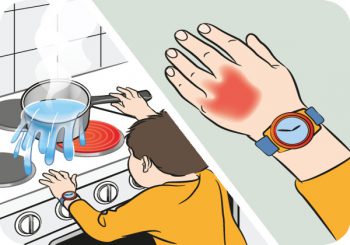By Sayer Ji
Contributing writer for Wake Up World
Burns that occur during the daily goings-on in life are hardly pleasant: touching the hot oven while baking cookies, spilling hot chocolate on skin or being out in the sun for too long. The good news is there’s a wealth of natural ways for you to treat those minor burns (read: those that aren’t open and don’t require a trip to the ER). Here are some techniques that you should take note of for the next unfortunate incident.
pro_ad_display_adzone id=”110028″]
1. Cool Water
When you get a minor burn, run cool, not cold, water over the area. Do this for about 20 minutes before washing the burn site with mild soap and water.
Refrain from soaking the wound in ice water. While immediately immersing the wound in ice water can yield benefits, including a less extensive, not-as-deep burn, if you wait more than 15 seconds the ice water will yield no benefits and can worsen the damage due to the potential for frostbite injury.[i]
2. Honey
In minor burns, pour tap water immediately on the burn site to reduce the temperature.[ii] Apply honey afterward. Depending on the area, 15 to 30 milliliters (ml) of honey can be used directly on the wound or applied via a honey-soaked gauze.
Honey is effective for preventing burn-related infections. In a study, honey dressing was compared with boiled potato peel dressings as a cover for fresh partial-thickness burns in 50 subjects.[iii] In those treated with honey, 90% of wounds were rendered sterile in seven days.
In more severe second-degree burns, topically applied honey prevented secondary infection, decreased healing time and reduced scarring.[iv] This was compared to topically administered pharmaceutical anti-infection cream.
Several different studies on animal models confirm honey’s ability to heal burn-associated wounds in multiple ways.[v],[vi] For instance, honey has antibacterial and anti-inflammatory properties along with low pH, high viscosity and hydrogen peroxide content, all contributing to its overall effectiveness against burns.[vii]
3. Aloe Vera
Often referred to as “the burn plant,” aloe vera is useful for addressing first- to second-degree burns.[viii] In a study on animal subjects, the researchers wrote, “Aloe vera could exhibit the actions of both anti-inflammation and wound healing promotion when applied on a second degree burn wound.”[ix]
A 2016 study evaluated 50 patients who had second-degree burns over 20% of their bodies.[x] Half of the patients were treated with a topical disinfectant while the others received dressings containing medicinal plants, primarily aloe vera. Those who were treated with aloe healed faster and had a shorter hospital stay.
Fermenting aloe vera may also significantly accelerate burn injury healing as it reduces the severity of inflammation and modifies gut microbiota.[xi]
4. Coconut
Coconut is known to have powerful antibacterial and antifungal properties, thanks in large part to its lauric acid content.[xii] In a study, researchers inflicted partial thickness burn wounds on animal models and assigned them into coconut, standard silver sulphadiazine and control groups.[xiii]
They found significant improvement in the contraction of burn wounds in the group treated with a combination of coconut and silver sulphadiazine. They concluded that the “oil of Cocos nucifera [coconut] is an effective burn wound healing agent.”
5. Curcumin
Curcumin, a compound found in the spice turmeric, offers anti-inflammatory as well as antioxidant effects.[xiv]
In animal studies, curcumin proved effective in reducing burn and injury progression in the subjects.[xv],[xvi] In comparison, the drug deferoxamine did not reduce burn progression, while the beneficial effects of curcumin appeared to be bimodal or having more than one mechanism of action. Along with St. John’s wort, curcumin also showed favorable results in healing second-degree burn wounds.[xvii]
6. Vitamin C
The antioxidant power of vitamin C, or ascorbic acid, and its role in collagen synthesis make it a vital molecule for skin health.[xviii] In fact, vitamin C deficiency is characterized by fragile skin and impaired wound healing.[xix] In a review, the use of antioxidant nutrients such as vitamin C lent health benefits to burn patients, from reducing infections rates and wound healing time to shortening the length of hospital stay.[xx]
While there’s much to be explored regarding the use of vitamin C in burn treatment, it remains a promising antioxidant candidate used in burn resuscitation studies, showing effectiveness in decreasing the fluid requirements in the acute phase after burn injury.[xxi]
In severe cases, high-dose vitamin C therapy was associated with reduced mortality in patients with severe burns when used under a minimum threshold of 10 grams within the first two days of hospital admission.[xxii] Various high-dose regimens may yield improved outcomes, the researchers wrote.
7. Papaya
Carica papaya is traditionally used in developing countries to treat wounds, particularly burns, as well as other skin disorders. In a study, papaya latex formulated as part of Carbopol gel proved effective in treating burns, thus supporting its traditional use.[xxiii]
In most regions of Africa, papaya is one of many natural medicinal preparations. In the pediatric unit of a hospital in The Gambia, Carica papaya was well-tolerated by child patients, where the pulp of the fruit was mashed and applied daily to full thickness and infected burns.[xxiv] Potentially at work are the enzymes chymopapain and papain, along with papaya’s antimicrobial activity.
Learn more natural solutions to burns from studies on the GreenMedInfo.com database.
References:
[i] UC San Diego School of Medicine https://web.archive.org/web/20230129015838/https://medschool.ucsd.edu/som/surgery/divisions/trauma-burn/about/burn-center/Pages/minor.aspx
[ii] Subrahmanyam M “Topical Application of Honey for Burn Wound Treatment – an Overview” Ann Burns Fire Disasters. 2007 Sep 30; 20(3): 137-139. Epub 2007 Sep 30.
[iii] Subrahmanyam M “Honey dressing versus boiled potato peel in the treatment of burns: a prospective randomized study” Burns. 1996 Sep;22(6):491-3.
[iv] Maghsoudi H et al “Comparison between topical honey and mafenide acetate in treatment of burn wounds” Ann Burns Fire Disasters. 2011 Sep 30 ;24(3):132-7.
[v] Farzadinia P et al “Anti-inflammatory and Wound Healing Activities of Aloe vera, Honey and Milk Ointment on Second-Degree Burns in Rats” Int J Low Extrem Wounds. 2016 May 23. Epub 2016 May 23.
[vi] Khoo Y et al “Wound contraction effects and antibacterial properties of Tualang honey on full-thickness burn wounds in rats in comparison to hydrofibre” BMC Complement Altern Med. 2010;10:48. Epub 2010 Sep 3.
[vii] Subrahmanyam M “Topical Application of Honey for Burn Wound Treatment – an Overview” Ann Burns Fire Disasters. 2007 Sep 30; 20(3): 137-139. Epub 2007 Sep 30.
[viii] Maenthaisong R et al “The efficacy of aloe vera used for burn wound healing: A systematic review” Burns. 2007 Sep; 33(6): 713-18.
[ix] Somboonwong J et al “Therapeutic effects of Aloe vera on cutaneous microcirculation and wound healing in second degree burn model in rats” J Med Assoc Thai. 2000 Apr;83(4):417-25.
[x] Zago L et al “The use of babosa (Aloe vera) in treating burns: a literature review” Braz J Biol. 2021 ;83:e249209. Epub 2021 Sep 20.
[xi] Hai Z et al “Evaluation of the Treatment Effect ofFermentation in Burn Injury Healing Using a Rat Model” Mediators Inflamm. 2019 ;2019:2020858. Epub 2019 Jan 27.
[xii] Srivastava P et al “Burn wound healing property of Cocos nucifera: An appraisal” Indian J Pharmacol. 2008 Aug; 40(4): 144-146.
[xiii] Srivastava P et al “Burn wound healing property of Cocos nucifera: An appraisal” Indian J Pharmacol. 2008 Aug; 40(4): 144-146.
[xiv] Singer A et al “Curcumin reduces injury progression in a rat comb burn model” J Burn Care Res. 2011 Jan-Feb;32(1):135-42
[xv] Singer A et al “Curcumin reduces burn progression in rats” Acad Emerg Med. 2007 Dec;14(12):1125-9.
[xvi] Singer A et al “Curcumin reduces injury progression in a rat comb burn model” J Burn Care Res. 2011 Jan-Feb;32(1):135-42
[xvii] Seyhan N et al “Evaluation of the Healing Effects of and Curcumin on Burn Wounds in Rats” Evid Based Complement Alternat Med. 2020 ;2020:6462956. Epub 2020 Feb 13.
[xviii] Linus Pauling Institute https://lpi.oregonstate.edu/mic/health-disease/skin-health/vitamin-C
[xix] Pullar J et al “The Roles of Vitamin C in Skin Health” Nutrients. 2017 Aug; 9(8): 866. Epub 2017 Aug 12.
[xx] Adjepong M et al “The role of antioxidant micronutrients in the rate of recovery of burn patients: a systematic review” Burns & Trauma. 2016 Aug 3.
[xxi] Rizzo J et al “Vitamin C in Burn Resuscitation” Crit Care Clin. 2016 Oct;32(4):539-46. Epub 2016 Aug 2.
[xxii] Nakajima M et al “Effect of high-dose vitamin C therapy on severe burn patients: a nationwide cohort study” Crit Care. 2019 Dec 12; 23(407).
[xxiii] Gurung S et al “Wound healing properties of Carica papaya latex: in vivo evaluation in mice burn model” Acta Pharm. 2005 Dec;55(4):417-22.
[xxiv] Starley I et al “The treatment of paediatric burns using topical papaya” Burns. 1999 Nov;25(7):636-9.
Recommended Articles by Sayer Ji:
- The Power and Mystery of Melanin Explained
- Cell Phone Induced Bodily Harm: How the Bees Can Help
- The Spice That Prevents Fluoride Destroying Your Brain
- How to Clean Your Arteries with One Simple Fruit
- 7 Healing Uses for Lavender Essential Oil
- From Table to Tomb: Cumin’s Health Benefits Rediscovered
- Why You Should Ditch Sugar in Favour of Honey
- The Love Affair Between Saffron and Humanity: As Ancient as Time Itself
- Why Walnut Resembles the Brain It Nourishes
- Magnesium Puts Psychiatric Drugs to Shame for Depression
About the author:
Sayer Ji is the founder of Greenmedinfo.com, a reviewer at the International Journal of Human Nutrition and Functional Medicine, Co-founder and CEO of Systome Biomed, Vice Chairman of the Board of the National Health Federation, and Steering Committee Member of the Global Non-GMO Foundation.
© 2020 GreenMedInfo LLC. This work is reproduced and distributed with the permission of GreenMedInfo LLC. Want to learn more from GreenMedInfo? Sign up for their newsletter here.
[pro_ad_display_adzone id=”110027″]








